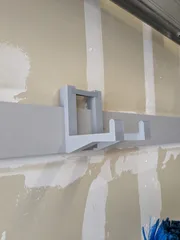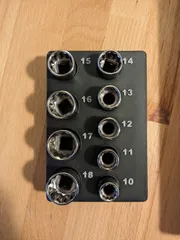Minnesota Tube Trainer
Description
PDFThis is a model of the human esophagus and upper part of the stomach. It is designed for clinicians to practice insertion of Minnesota tubes or Sengstaken-Blakemore tubes.
The model is made of four parts, three pieces of esophagus and one stomach which are attached to each other with M3 screws and M3 nuts. The model was originally created by the Optogenetics and Neural Engineering CORE at the University of Colorado, Denver. The stand is my own design but the model has many mounting points so can be mounted however you would like.
Print Settings
Supports: Required for each part. Removing Supports was probably the most difficult part of the print, especially inside the esophagus. Organic supports seemed to be the easiest to remove. Be sure to check for sharp bits of plastic so you don't accidentally cut the balloon
Filament: I used a natural PLA from Push Plastic. A stiff TPU is also a good choice to give it a bit more of a realistic feel but isn't necessary.
Temperatures: I used the standard PLA profile in PrusaSlicer without problems.
Assembly
Each piece has several holes to connect it to its neighbor. I put M3 screws through each hole and an M3 nut on the other side. A few holes needed to cleaned out with a drill bit before the the screw would fit. The holes are arranged in a way that each piece can only connect to its neighbors in the correct orientation. Glue could certainly be used to strengthen the joints but I wanted to keep it modular in case any piece broke.
Mount
The base of the mount is a 17.5" diameter round piece of wood from Home Depot but you could use anything that would be heavy and stable enough to take the 1kg of traction a Minnesota Tube needs.
The post is a 1.25" x 1.25" x 20" post I also bought pre-cut from Home Depot. I placed a lag screw from the bottom of the base into the post to secure them together. Make sure the lag bolt is countersunk so the mount rests flat. A smaller diameter wood screw next to the lag bolt prevents the post from twisting.
The esophagus is then attached to the mount with 3mm diameter rods which I threaded with an M3 die so they could be attached with M3 bolts and washers. There is likely much easier ways to attach the esophagus but I wanted this initial model to look pretty.
I want to stress that how you mount this is very flexible. The model is strong enough that you could actually hold it in your hands while someone practices insertion.
Thanks to Andrew Scallon at the University of Colorado, and Dr. Christopher Mowry for designing the model and helping me get this posted. If anyone wants help with designing a mount or using the trainer please let me know! I also attached my favorite Minnesota Tube reference which is from ICU Onepager.
Tags
Model origin
The user re-uploaded this model. The user is not the original author of the model.



